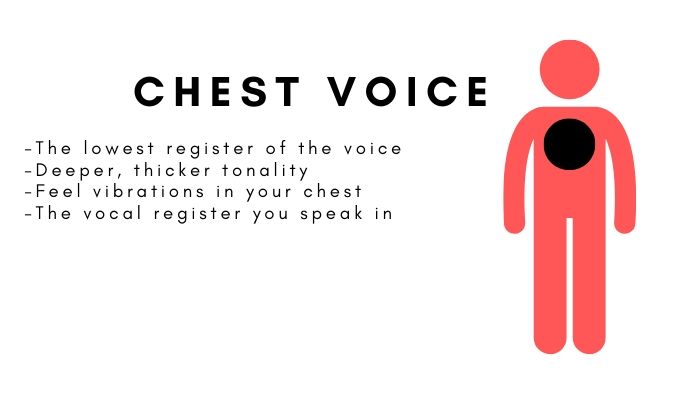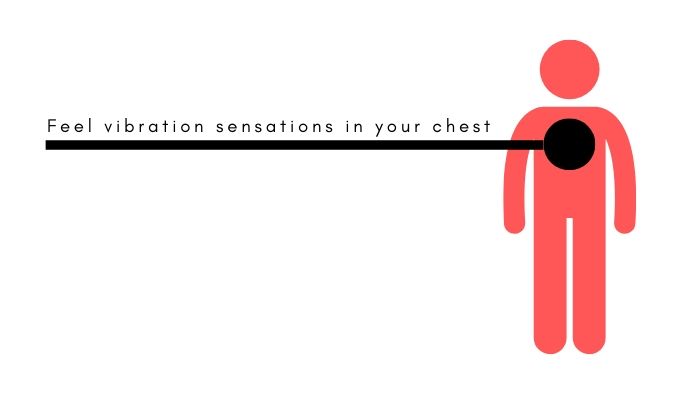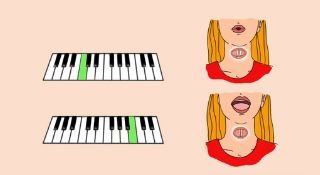What Is Chest Voice?

On this page you’ll discover what “chest voice” is, and how you can have that powerful chest voice sound through your whole vocal range.
You may or may not have heard the three “descriptions” of your vocal registers. These being chest voice, mixed voice, and head voice.
While these are important ideas to understand, there are some even more important concepts that will help you get the most from your singing.
Let’s begin by watching this video, which goes over these concepts.
The Secret To Star Singing
Click HERE For The Secret To Star Singing
The Secret To Star Singing
Click HERE For The Secret To Star Singing
What Is Chest Voice In Singing?
What is the definition of chest voice?
The very simple explanation is that chest voice is that low to middle part of your voice, in the same range where you speak.
It’s usually an easy part of the voice to sing in, although for women it can sometimes be more difficult.
Also, chest voice is the lowest part of your vocal range.
Technically speaking, your vocal folds are vibrating across their entire length when you’re singing with chest voice.
The term “chest voice” comes from the sensations you feel in your chest when you are using it.
Your chest voice is most useful when singing melodies that are lower in your vocal range.
Also, if you’re singing rock songs with an edge to them, chest voice is your friend!
If you'd like to learn about the different parts of your vocal range, check out this tutorial: Chest voice vs head voice vs falsetto.
Singing Coaches Disagree!
Look.
Singing teachers often have different ideas about chest voice.
What's important though is that you have a simple understanding of it. Enough where you know how to use chest voice without over thinking things.
So here's some basic criteria to help you understand when you are singing in chest voice.
- Chest voice has a “deeper” more powerful sound or timbre than your mixed voice or head voice
- You feel a vibrating sensation in your chest when you’re using it
- It’s easier to sing in chest voice in the lower parts of your range
 When you are using your chest voice it can feel like the sound is resonating in your chest.
When you are using your chest voice it can feel like the sound is resonating in your chest.Keeping That Fashionable "Chest Voice" Sound
For many styles of music, singers really want to have that “chest” sounding quality throughout their entire vocal range.
This is because “chest voice” has a certain powerful quality to it, that head voice does not.
And it is possible to maintain this “chest” sound into your upper vocal registers, with some special techniques of singing. More about this in a second.
The Problem With Chest Voice
Ok, so here is the problem.
When you want to get that “chest” voice sound higher in your range, it’s very tempting to “push” for it.
And when you do this you immediately put strain on your voice, and your tone quality suffers badly.
So how can you overcome this problem?
The answer is developing a “mixed voice”.
Your mixed voice is a “mixture” of chest voice and also your head voice.
To watch a video on how to develop your mixed voice, click here.
Also, in the video up the top of this page, you’ll see a demonstration how to sing chest voice with a powerful sound, but with a subtle mixture of head voice in there as well.
Always Have At Least A Slightly Mixed Voice
The ultimate goal is to always be singing with a mixed voice, even if there is only a little of chest voice or a little of head voice.
The reason is, if you’re singing completely in one register, it makes it difficult to navigate to the register above or below.
For example, when a singer is struggling to get a high note, the reason is often because of what they are doing the note before.
See, if the sound is incorrectly positioned the note before the high note, your voice can not fall into position to get the high note.
Whereas, if you’re singing a lower note with some head voice mixed in, and then you sing up to a high note, it’s much easier to get there with no problems.
How To Increase Chest Voice Range
As we've just touched upon, you can get that "chest like" quality in the higher parts of your vocal range by developing a mix of your chest voice and head voice.
If you'd like to develop this ability, check out this tutorial dedicated to singing high notes in chest voice.
Master Your Voice
If you want to really master your voice, the answer is to practice the techniques of singing that are going to balance your voice and get it operating efficiently and correctly.
You can get a free video series that will take you through some of these exercises as well as many important singing concepts.
To get this video series, click the link below.
Click Here To Get These Techniques Of Singing
Frequently Asked Questions About Chest Voice
What is the difference between head voice and chest voice?
Let's look at chest voice vs head voice.
Chest voice is the same vocal register you use to speak. It has a deep, thick quality and it also gives you a vibration type sensation in your chest.
Head voice on the other hand is usually used higher in your range. It has a softer, sweeter sound to it. When you're singing in head voice it feels like your sound is vibrating in your head.
Technically speaking when you are in your head voice, your vocal folds have shortened, leaving less of the chords to vibrate as opposed to in your chest voice.
What is a mix voice?
Singing in mixed voice is when you blend the chest voice and head voice together. This is ideal because it gives you the best qualities of each. You get the power and the thickness of chest voice, and the sweetness of head voice.
By blending chest voice and head voice together you can also sing throughout your range with your tonality staying nice and balanced. Check out this exercise series to help develop your mixed voice.
About The Author
 Roger Burnley - Vocal Coach Roger Burnley - Vocal Coach |
Roger Burnley is a vocal coach located in Hollywood, California. He has been teaching singers for over 30 years and singing for even longer than that.
Notable past and present clients include Macy Gray, Brandy, Ray J, The Beastie Boys, James Torme, Taylor Lautner, Nona Gaye, and many more.
His clients have collectively sold more than 30 million albums, with several reaching Platinum and Gold status.
Roger has been featured on VH1, TV Guide Channel, TV One,
and MTV appearing as a vocal expert.
About The Author
 Roger Burnley - Vocal Coach Roger Burnley - Vocal Coach |
Roger Burnley is a vocal coach located in Hollywood, California. He has been teaching singers for over 30 years and singing for even longer than that.
Notable past and present clients include Macy Gray, Brandy, Ray J, The Beastie Boys, James Torme, Taylor Lautner, Nona Gaye, and many more.
His clients have collectively sold more than 30 million albums, with several reaching Platinum and Gold status.
Roger has been featured on VH1, TV Guide Channel, TV One,
and MTV appearing as a vocal expert.









New! Comments
Show me you're alive! Leave a comment below...